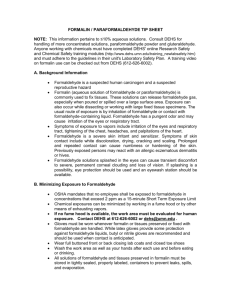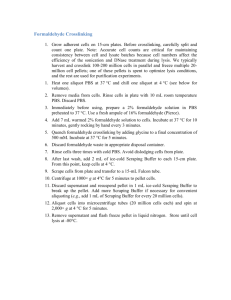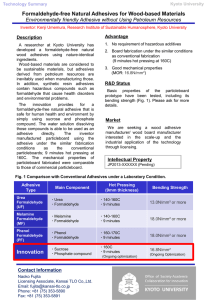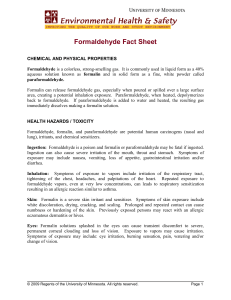Formaldehyde SOP Template
advertisement
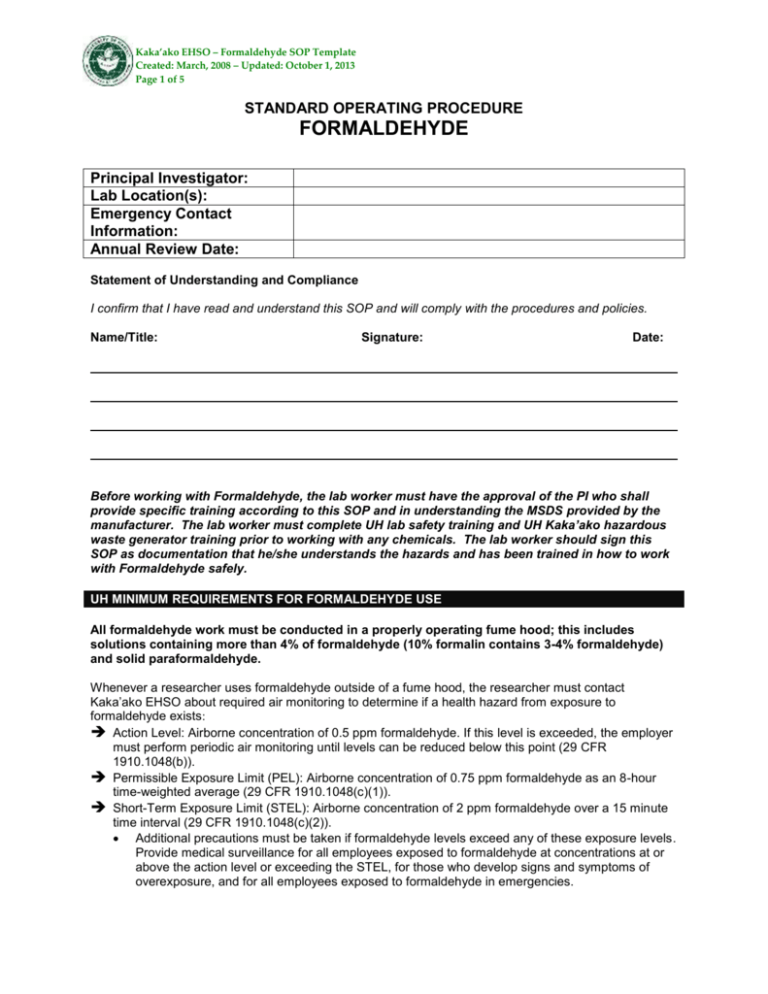
Kaka’ako EHSO – Formaldehyde SOP Template Created: March, 2008 – Updated: October 1, 2013 Page 1 of 5 STANDARD OPERATING PROCEDURE FORMALDEHYDE Principal Investigator: Lab Location(s): Emergency Contact Information: Annual Review Date: Statement of Understanding and Compliance I confirm that I have read and understand this SOP and will comply with the procedures and policies. Name/Title: Signature: Date: Before working with Formaldehyde, the lab worker must have the approval of the PI who shall provide specific training according to this SOP and in understanding the MSDS provided by the manufacturer. The lab worker must complete UH lab safety training and UH Kaka’ako hazardous waste generator training prior to working with any chemicals. The lab worker should sign this SOP as documentation that he/she understands the hazards and has been trained in how to work with Formaldehyde safely. UH MINIMUM REQUIREMENTS FOR FORMALDEHYDE USE All formaldehyde work must be conducted in a properly operating fume hood; this includes solutions containing more than 4% of formaldehyde (10% formalin contains 3-4% formaldehyde) and solid paraformaldehyde. Whenever a researcher uses formaldehyde outside of a fume hood, the researcher must contact Kaka’ako EHSO about required air monitoring to determine if a health hazard from exposure to formaldehyde exists: Action Level: Airborne concentration of 0.5 ppm formaldehyde. If this level is exceeded, the employer must perform periodic air monitoring until levels can be reduced below this point (29 CFR 1910.1048(b)). Permissible Exposure Limit (PEL): Airborne concentration of 0.75 ppm formaldehyde as an 8-hour time-weighted average (29 CFR 1910.1048(c)(1)). Short-Term Exposure Limit (STEL): Airborne concentration of 2 ppm formaldehyde over a 15 minute time interval (29 CFR 1910.1048(c)(2)). Additional precautions must be taken if formaldehyde levels exceed any of these exposure levels. Provide medical surveillance for all employees exposed to formaldehyde at concentrations at or above the action level or exceeding the STEL, for those who develop signs and symptoms of overexposure, and for all employees exposed to formaldehyde in emergencies. Kaka’ako EHSO – Formaldehyde SOP Template Created: March, 2008 – Updated: October 1, 2013 Page 2 of 5 Results of formaldehyde monitoring must be documented and must include: dates, number, and results of testing; methods used in testing and taking air samples; description of any type of respirators worn; the names and social security numbers of the people exposed This monitoring documentation must be kept in the individuals confidential medical records with human resources for the duration of employment plus 30 years Departments using the formaldehyde must show the written results of all formaldehyde testing to all affected workers. Notification must be made within 15 working days after receiving the results Notification must include what actions are being taken to bring the formaldehyde level down if the PEL has been exceeded Everyone who works with formaldehyde has the right to observe the testing procedures 1. INFORMATION ABOUT FORMALDEHYDE Formaldehyde CAS#50-00-0 Formaldehyde is a colorless, strong-smelling gas. It is commonly used as a preservative in medical and research laboratories, and widely used as an industrial fungicide, germicide and disinfectant. Formaldehyde solution can be useful as a disinfectant as it kills most bacteria and fungi and is commonly used in histology to preserve or fix tissues or cells. Formaldehyde is usually commercially available in a 37% solution. 37% formaldehyde solution in water and methanol is a flammable corrosive liquid and must be stored in flammable storage. Formaldehyde is classified a select carcinogen by OSHA and OSHA has developed a standard to protect workers against occupational exposure 29 CFR 1910.1048 and a fact sheet. Formalin A common synonym for formaldehyde is formalin, but pay attention to the concentration of solutions labeled formalin as they may differ, e.g. formalin for histology use is usually a 10% formalin solution of 37% formaldehyde, and therefore it contains 3-4% formaldehyde. “Formalin” and “10% formalin” are not the same thing, though we find that researchers use these interchangeably to refer to 10% formalin. A 10% formalin solution shall be considered an irritant and a potential carcinogen and must be handled carefully, but, it is not covered under this SOP and may be used on the open benchtop. Paraformaldehyde CAS#30525-89-4 Paraformaldehyde is a white crystalline powder of polymerized formaldehyde. It is classified as a suspect carcinogen and a flammable solid; therefore must be stored in flammable storage. The powder can easily become airborne and enter the respiratory system; therefore it can only be used in the fume hood. Solutions of 4% or greater paraformaldehyde shall be covered under this SOP. 2. HAZARDOUS PROPERTIES, POTENTIAL ROUTES OF EXPOSURE, SYMPTOMS OF EXPOSURE Formaldehyde is classified as a select carcinogen by OSHA. Symptoms of exposure include irritation/burns of the eyes, skin and respiratory tract, tightening of the chest, headaches, and palpitations of the heart. Acute Effects: Exposure to gaseous formaldehyde by inhalation may result in sensory irritation of the upper respiratory tract and eyes. Skin contact with formaldehyde may result in irritation and dermatitis. May be harmful if swallowed or absorbed through the skin. May result in corneal injury if exposed to eye. Routes of Exposure Formaldehyde can enter the system through the eyes, mucous membranes, absorption though skin, by inhalation or ingestion. Workers can inhale formaldehyde as a gas or vapor or absorb it through the skin as a liquid. Groups at high risk include medical lab technicians, health care professionals, mortuary employees, teachers and students, who handle biological specimens preserved with formaldehyde or formalin. Kaka’ako EHSO – Formaldehyde SOP Template Created: March, 2008 – Updated: October 1, 2013 Page 3 of 5 Chronic Effects: Prolonged respiratory exposure to formaldehyde may result in asthma and chronic bronchitis. High concentrations of inhalation may cause anosmia (loss of smell) and pulmonary edema. May cause severe digestive tract irritation with abdominal pain, nausea, vomiting and diarrhea if ingested. Repeated eye contact may result in conjunctivitis and blindness. May cause central nervous system depression, liver and kidney damage. Concentrations of 100 ppm are immediately dangerous to health or life. Cancer Hazard: Formaldehyde was determined to be a probable human carcinogen. There is sufficient evidence that formaldehyde causes nasopharyngeal cancer in humans. There is limited evidence that formaldehyde causes cancer of the nasal cavity and paranasal sinuses. There is strong but not sufficient evidence that is causes leukemia. Reproductive Hazard: May cause adverse reproductive effects. 3. PERSONAL PROTECTIVE EQUIPMENT Impermeable gloves should be used when potential for skin contact exists; gloves shall be changed frequently. Disposable nitrile, neoprene, natural rubber, PVC, or butyl gloves should be worn, as latex gloves are not recommended for handling Formaldehyde (confirm glove type and use limitations by referring to the JABSOM Glove Compatibility and Use Guide - contact Kaka’ako EHSO). Safety glasses with side shields or chemical splash goggles shall be worn. A laboratory coat should be worn when working with chemicals. Closed toe shoes are required when working in the laboratory. If the user chooses to wear a dust mask to avoid inhalation when working with paraformaldehyde, OSHA regulations specify that certain requirements and trainings be met before purchasing masks and use of masks and respirators, contact Kaka’ako EHSO for more information. A lab worker can avoid exposure to the powder form without wearing a respirator if manipulation is restricted to a properly operating fume hood. If formaldehyde levels exceed the OSHA PEL, wear a NIOSH/MSHA approved respirator. 4. ENGINEERING/VENTILATION CONTROLS Work with paraformaldehyde in a properly operating and certified chemical fume hood. Work at least 6” inside the hood, never place your head in the hood, set the sash at the lowest position possible (if using the horizontal sliding sashes do not open past the labeled positions). Safety shower and eye wash stations should be easily accessible where formaldehyde is used. Engineering controls should be used whenever feasible to maintain airborne paraformaldehyde concentrations at the lowest achievable levels. 5. SPECIAL HANDLING PROCEDURES AND STORAGE REQUIREMENTS Keep container tightly closed to prevent agent from subliming and entering the atmosphere. Store in a cool and dry area away from incompatible substances (i.e. oxidizing agents, strong bases/acids). Only approved explosion-proof refrigerators should be used for cold storage of formaldehyde or paraformaldehyde. Specimens preserved in formalin may be used on benchtop if adequate ventilation is available. Avoid generating dust Wash hands thoroughly after handling (even if gloves were used). Remove contaminated clothing/PPE and wash before reuse. Keep away from heat, sparks, flames, sources of ignition (including empty containers that will retain product residue). Kaka’ako EHSO – Formaldehyde SOP Template Created: March, 2008 – Updated: October 1, 2013 Page 4 of 5 Transport chemicals in closed containers, in the smallest amounts possible, and use aids such as carts, chemical transport carriers, etc. It is highly recommended that all chemicals be stored below eye level so cracking or leaking containers are immediately visible and there is less potential for chemicals falling onto lab workers when pulling from shelves. 6. PROCEDURES ****Modify this section to reflect your lab specific procedures! Bench covers should be disposed via EHSO upon contamination from spilling or after usage. Measuring Paraformaldehyde Powder o When measuring out paraformaldehyde, work in a certified chemical fume hood, and weigh into a pre-measured covered container. o Wear gloves, a lab coat, and goggles during measuring, weighing, and mixing operations. o If there is a risk of splash, wear a full face shield. o Ensure that the entire hand and arm area is covered. o Do not allow a break in protective coverage at the wrist if coat and gloves do not overlap. o Tightly close container during transport. o The closed container can then be moved safely from the hood to the balance to be weighed. If more or less material is needed, return the container to the hood and adjust the amount of material. Handling Formaldehyde Solutions o Wear appropriate PPE (gloves, eye protection, lab coats). o Change gloves after handling formaldehyde. o Work in a well ventilated area. 7. SPILL AND ACCIDENT PROCEDURES Do not attempt cleanup if you feel unsure of your ability to do so or if you perceive the risk to be greater than normal laboratory operators. In the event of skin contact, immediately wash with soap and copious amounts of water and remove contaminated clothing. Seek medical attention. Do not use disinfecting chemicals such as ethanol or bleach as this could actually increase skins permeability to ethidium bromide. In case of contact with eyes, immediately flush eyes with copious amounts of water for at least 15 minutes (lifting upper and lower eyelids occasionally) and obtain medical attention. If inhaled, move to fresh air immediately and seek medical attention. In the event of ingestion, obtain medical attention immediately. Do not induce vomiting unless directed to do so by medical personnel. If spill is on equipment, use ultraviolet light to locate spill (if can be done safely), then decontaminate according to Section 8 below. If a large amount of Paraformaldehyde or formaldehyde is inhaled, move the person to fresh air and seek medical attention at once. Report all incidents or near misses to Kaka’ako EHSO and complete the appropriate Incident Forms. Small spills: Don appropriate PPE. If potential respiratory hazard exists, contact Kaka’ako EHSO. Collect spilled material and clean up material into appropriate waste container. Small liquid spill: Absorb freestanding liquid with inert materials (vermiculite, sand or earth), dry paper towels or absorbent material and place into containers for disposal. Remove all sources of ignition. You may also allow them to evaporate in a fume hood prior to disposal. Wash spilled area with soap and water. Small dry spill: If the powder is spilled, wet paper towels and carefully lay on top of the powder to avoid creation of airborne dust when cleaning the spill. Wear respiratory protection. Kaka’ako EHSO – Formaldehyde SOP Template Created: March, 2008 – Updated: October 1, 2013 Page 5 of 5 Large spills: Notify others in room of spill. Evacuate room/immediate area. Call Security and Kaka’ako EHSO. Post warning signs at entrances/exits notifying others of spill. Prevent unnecessary entry into area. Provide assistance and information to spill responders. Report all spills (minor and major) and any near misses to Kaka’ako EHSO. 8. WASTE DISPOSAL PROCEDURES Formaldehyde solutions are classified as a flammable hazardous liquid and paraformaldehyde is classified as a flammable hazardous solid. Both must be properly disposed of through Kaka’ako EHSO. For UH Kaka’ako, the drain disposal restriction on formaldehyde solutions (diluted) that may be poured down the drain if it is <3% by weight and <1 quart per day per laboratory. Gloves, test tubes, paper towels, etc. that are contaminated with formaldehyde should be also collected for hazardous pickup by Kaka’ako EHSO. 9. MSDS LOCATION ****Where is this located, as an attachment to the SOP, in the MSDS folder, etc? Must have an MSDS, preferably manufacturer specific, specific for each type of formaldehyde used (per CAS#). References: Information contained in this SOP was gathered from the following sources: Ohio State University, Fisher Scientific (MSDS), OSHA Fact Sheet-Occupational Exposure to Formaldehyde and 29 CFR 1910.1048, and Lab Safety Supply EZ Facts.

